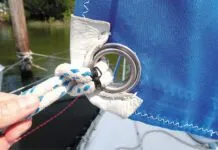Hull Speed & Propeller Thrust
Where can I find the formula to determine hull speed for my Cal 34?
I would also like to determine if I have the proper propeller on my 30-hp. Atomic 4. I just had the engine rebuilt but maximum engine speed is only 2,600 rpm. According to the Atomic 4 manual, 30-hp. is achieved at 3,500 rpm.
Is there a formula that relates thrust forces to hull speed and the various elements of a propeller, i.e., pitch, diameter, rpm and horsepower?
Mike Alberts
Commerce, Michigan
The formula for determining hull speed can be found in most any yacht design text. Its simple: hull speed equals the square root of the waterline length x 1.34. So, for your Cal 34, with its 26′ waterline, the answer is 6.832 knots.
Formulas for determining ideal propeller diameter and pitch are much more complicated. We suggest you read Dave Gerrs Propeller Handbook, if you really want to get into it. Far simpler is consulting with a prop shop, which should have a formula in its computer. Theres a bit of black magic involved, too, or at the least, experience required. For example, the formula might suggest a 15″ prop, but if you don’t have at least 10% tip clearance with the hull, youll have to go with a smaller diameter prop. Smaller diameter means more pitch to compensate. Its coming up with the ideal combination of diameter and pitch. Usually you want the most diameter possible, then turn your attention to pitch.
For choosing a prop for an Atomic 4, a good source of information is Don Moyers Atomic 4 newsletter (Moyer Marine Inc., 3000 Derry St., Harrisburg, PA 17111; 717/564-5748). And in a 1976 Motor Boating & Sailing article, author Gordon Groene said that for a 40-footer with direct drive Atomic 4, you want a prop that allows the engine to turn at least 3,000 rpm, but only 2,000 rpm for a boat under 30-feet. Your boat falls somewhere in between.
In short, you should be able to achieve near hull speed at something less than full throttle, leaving the reserve for emergencies. In your case, you should make 6-1/4 or 6-1/2 knots at your 2,600 rpm (3/4 throttle) setting. If you are not, then the pitch is probably too great. Similarly, when turning 3,500 rpm and making less than hull speed, you don’t have enough pitch.
Displacement Vs. Planing Hulls
Were hung up on several boats. Mostly, its a matter of a choice of the basic type of boat we want. If you had to use but four good-bad words to describe displacement hulls and sailboats that will plane, what would they be?
Tom Snyder
Chicago, Illinois
Displacement hulls: comfortable, slow. Planing hulls: fast, demanding.
Natural Teak Getting Rough
We live aboard a boat with a teak deck. We leave the teak natural. We like the beautiful bone color. We clean it once a week with soap and a scrub brush on a handle. The teak is getting rougher and rougher. What are we doing wrong?
Frank Baxter
Houston, Texas
Were guessing, but the brush bristles probably are too stiff. As with any wood, teak has both soft and hard cellular linkages in its structure. The soft stuff is fragile, and can simply vanish if treated harshly with either chemicals (as in many teak cleaner/teak oil kits) or scrubbing.
Scrubbing with the grain gouges out the soft part of the teak. The teak will last longer, comparatively speaking, if you use a mild soap, a very soft brush and avoid scrubbing with the grain.



































